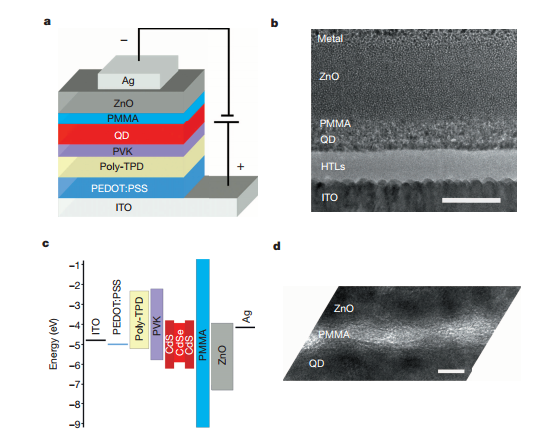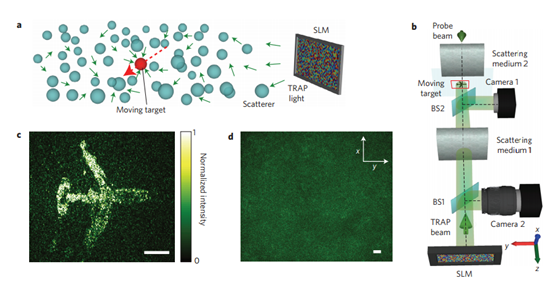一、 本期重点
1、基于溶液工艺的高性能量子点LED(Solution-processed, high-performancelight-emitting diodes based on quantum dots)【Nature】
Doi: 10.1038/nature13829
Published: 2014.11.6
内容介绍:
由于大面积器件低成本制作的可能性和与轻的软塑料基板的兼容性,基于溶液工艺的光电和电子器件非常具有吸引力。在过去的二十年中,使用共轭聚合物或者量子点作为发射器的基于溶液工艺的LEDs已经引起了很大的关注。然而,基于溶液工艺的LEDs的总体性能——包括他们的效率、高电流强度时的效率衰减、开启电压和实际情况下的寿命——与最好的真空沉积的有机LEDs相比仍然处于劣势。这里我们报告了一种基于溶液工艺的、基于多层量子点的LED,其性能优良,可再现性高。它展示了颜色饱和时的深红色发生,子能级在1.7伏电压时开启,20.5%的高外部量子效率,低的效率衰减(在100mA cm-2时达到外部量子效率的15.1%),以及在100 cd m-2时超过10万小时的运行寿命。这使得它成为了目前性能最好的基于溶液工艺的红光LED,与最先进的真空沉积的有机LEDs相媲美。通过在量子点层和氧化物电子输运层之间插入一个绝缘层,来优化器件中的电荷平衡并且保持量子点中优越的发射性能,实现了该器件的良好的光电性能。我们预期我们的成果将会成为未来研究的一个新起点,对用于下一代显示的高性能全溶液工业的基于量子点的LEDs和固态发光技术都有重要意义。

图1 多层QLED器件。a,器件结构。b,横截面的透射电子显微成像表明明显对比的多层材料。c,平坦带的能级水平示意图。d,高放大率的透射电子显微成像,显示在及其薄的样品很截面中,PMMA层在ZnO层和量子点层之间
2、时间反转适应扰动光聚焦到散射介质中的动态物体(Time-reversed adapted-perturbation (TRAP)optical focusing onto dynamic objects insidescattering media)【Nature Photonics】
Published online: 2014.11.2
Doi: 10.1038/NPHOTON.2014.251
内容介绍:
在散射介质中操纵和聚焦光一直都有很多的应用。目前,唯一可行的方法来形成散射介质中的光焦点是植入的或者虚拟的导引星,然而这很不方便并且限制了可能的应用。这里我们报道了一种方法来聚焦散射介质中的光,通过使用固有的动力学规律作为引导星。通过适应性地对散射光的扰动部分做时间反转,我们发现有可能把光聚焦到扰动的源点处。通过这种方法我们证明无侵入的光聚焦到动态物体上,并且能够对被高度散射介质掩盖的时间变化物体进行成像。可能的应用包括血管肿瘤的成像和光切除,以及其他的生物应用。

图二动态光聚焦到散射介质中一个移动物体上。a,概念解释。来源于SLM的光聚焦到一个散射介质中的运动物体。b,实验组织。c,焦点处光能的分布。d,探测过程中的SLM上的散斑模式。比例尺,500um。
二、 简讯
Published: 2014.11.10
Abstract:
In this Letter, we demonstrate a fully stabilized Er:fiber frequency comb by using a fiber-based, high-precision optical-microwave phase detector. To achieve high-precision and long-term phase locking of the repetition rate to amicrowave reference, frequency control techniques (tuning pump power and cavity length) are combined togetheras its feedback. Since the pump power has been used for stabilization of the repetition rate, we introduce a pair ofintracavity prisms as a regulator for carrier-envelope offset frequency, thereby phase locking one mode of the comb
to the rubidium saturated absorption transition line. The stabilized comb performs the same high stability as thereference for the repetition rate and provides a residual frequency instability of3.6×10−13for each comb mode. Thedemonstrated stabilization scheme could provide a high-precision comb for optical communication, direct frequency comb spectroscopy.
Published: 2014.11.7
Abstract:
All-optical temporal integrator using phase-shifted distributedfeedback semiconductor optical amplifier (DFB-SOA) is investigated. The influences of system parameters on its energy transmittance and integration error are explored in detail. The numerical analysis shows that, enhanced energy transmittance and integration time window can be simultaneously achieved by increased injected current in the vicinity of lasing threshold. We find that the range of input pulse-width with lower integration error is highly sensitive to the injected optical power, due to gain saturation and induced detuning deviation mechanism. The initial frequency detuning should also be carefully chosen to suppress the integration deviation with ideal waveform output.
Doi: 10.1364/OE.22.028443
Published: 2014.11.7
Abstract:
Phoxonic crystal is a promising material for manipulating sound and light simultaneously. In this paper, we theoretically demonstrate the propagation of acoustic and optical waves along the truncated surface of a two-dimensional square-latticed phoxonic crystal. Further, a photonic crystal hetero-structure cavity isproposed, which can simultaneously confine surface acoustic and optical waves. The interface motion and photoelastic effects are taken into account in the acousto-optical coupling. The results show obvious shifts in eigenfrequencies of the photonic cavity modes induced by different phononic cavity modes. The symmetry of the phononic cavity modes plays a more important role in the single-phonon exchange process than in the case of the multi-phonon exchange. Under the same deformation, the frequency shift of the photonic transverse electric mode is larger than that of the transverse magnetic mode.
Doi: 10.1364/OL.39.006478
Published: 2014.11.11
Abstract:
We demonstrate an on-chip four-wave mixing (FWM) scheme in a silicon nano-waveguide to scale the bandwidthof a frequency comb generated by phase modulation of continuous-wave (CW) lasers. The FWM process doublesthe bandwidth of the initial comb generated by the modulation of a CW laser. For example, a wavelength-tunablefrequency comb with>100comb lines spaced by 10 GHz within a bandwidth of 5 dB is generated.
供稿:段昌琪







